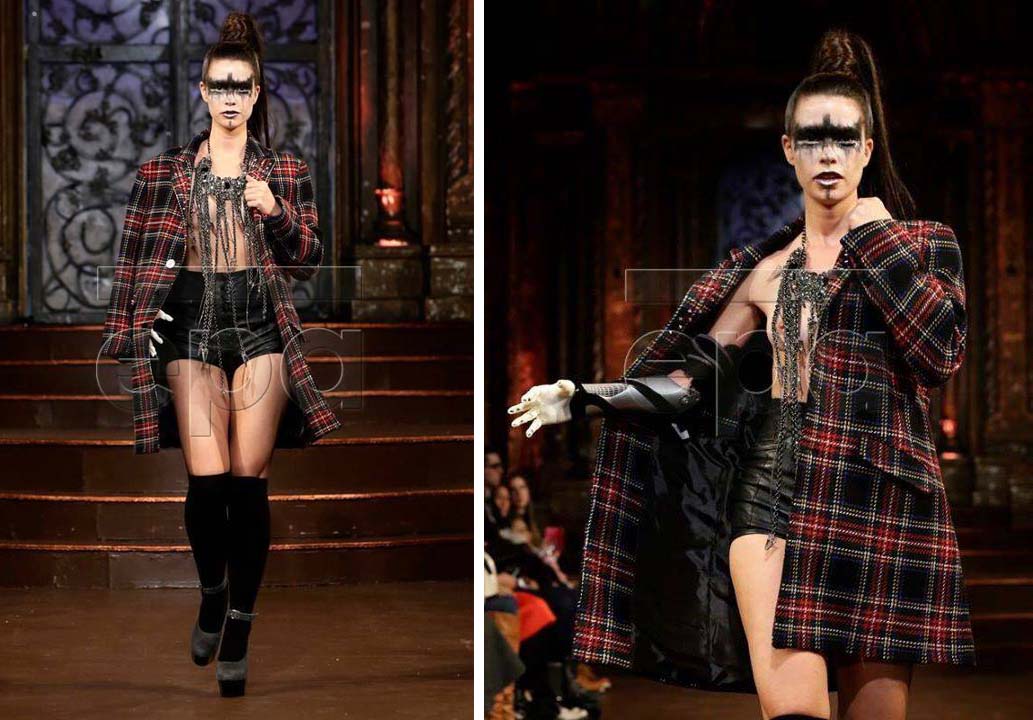Limbitless Solutions has, up until now, been focused on 3D printing bionic arms for kids who, because they are constantly growing, benefit from a low-cost solution that can grow with them. One kid in particular, named Alex Pring, became an Internet sensation last year when Limbitless and one very recognizable celebrity gifted the seven-year-old, born with a partially formed right arm, with a 3D printed Iron Man prosthetic. Since then, the Florida non-profit, founded by PhD candidate Albert Manero, has continued to grow in its own right, building its very first prosthetic for an adult client.

Shaholly Ayers is no average adult, however. Ayers has, in recent years, become a well-known model with a mission to represent diversity on the runway. Born a congenital amputee, with no right arm below the elbow, Ayers has been featured on the BBC, Adult Swim, and in the recent Nordstrom Anniversary Catalog. This year may have been her most important gig yet, however, as the first model to grace the runways of NYFW with a 3D printed, bionic limb.
The Limbitless prosthetic has a number of advantages over model Rebekah Marine’s i-limb, which she sported at NYFW last year, the most obvious being cost. While an i-limb can cost anywhere from $38,000 to more than $120,000, a Limbitless solution can be as low as around $350, though the non-profit ensures that those in need can get their prosthetics at no cost. Not only was Shaholly’s arm cheaper to produce, however; Limbitless founder Albert Manero tells me that it is also much lighter than the alternatives. “Shaholly has an EMG arm already and she said she couldn’t believe the weight difference,” Manero says. “She said it was the lightest arm she’d every worn.”
Shaholly’s arm was printed in ABS plastic with FDM technology, for the most part, aside from the clear lattice on the wrist, which was printed with PolyJet. “All the plastic is pretty light to begin with, but our electronics, our motor, and our battery are all really minimized right now and the lattice framework definitely helps,” Albert explains.

Limbitless Solutions is just one organization in a growing number of players attempting to increase access to low-cost medical devices. And, as this trend has gotten an increasing amount of attention from the media and large corporations alike, it’s startling to see that traditional medical device manufacturers have yet to jump in to show their support for affordable prosthetics.
Albert speaks to the new phenomenon, saying, “The technology is moving really fast, when you consider that, three years ago, the technology just did not exist outside of a research lab or a $40,000 – $50,000 device.” He continues, “The traditional system has failed a lot of people and we’ve noticed this with children. Our hope is that we can use technology and engineering to restore what was lost to those sectors of humanity. By the way, kids are immediate victims because they grow and the insurance companies actually say that, if you lose an arm, it’s not a necessity to have it replaced for a child. Only legs are a necessity. And we found that perspective to be such a shame.”

“Our belief is that all children are created equal, regardless of how much money their families have. Our goal is to find partners and sponsors to keep families from having to pay,” the founder adds. But the demand for low-cost devices is not limited to the United States by any means. As one would expect, there is a great demand for such prosthetics in war-torn regions, like the Middle East, where amputation occurs far too frequently. In the future, the non-profit hopes to finalize its designs and increase the means for producing these arms in order to provide for the growing need for low-cost prosthetics worldwide.
“Our partners in the Middle East want like 10,000 of these arms to be able to help all of the refugees there,” he tells me. “There’s no shortage of people in need there. And there’s no way that people are going to be able to donate medical-grade, hundred-thousand-dollar devices. A million dollars could purchase ten to twenty medical-grade EMG arms versus 3,000 Limbitless arms. So, we definitely see that, for the kids, there’s a huge opening to make a big impact even with our small technology.”
While Limbitless works to establish a method for increasing production, the work they achieved with Ayers in particular gave Limbitless and the model a chance to have an impact on the world right now by reducing the potential stigma for girls and women in our society to wear a bionic limb. To achieve this goal, they crafted the limb to be particularly attractive from an aesthetic standpoint.

“We talked a lot with Shaholly about how a lot of the requests that come into us are from families with boys because, with girls, there’s more stigma and less of an inclination towards robotics and science just in how our society is structured right now,” he says. “So, we want to show that the arms are beautiful. We’ve heard a lot about our Iron Man arms, but we wanted to open up our designers to really have some fun with this one and really try to make it exceptionally beautiful. And the next project we’re doing in March – that one too is designed to show both femininity and grace, as well as strength and the robotics, to demonstrate that you can have it all.”

From the looks of the model’s work on the catwalk of Mr. Decurtis’s show for FTL MODA, under her agency Global Disability Inclusion, LLC, Ayers and Limbitless have proven that a bionic arm need not be a device suited only for Iron Man, but that it can be a fashion accessory, as well.
Feature photo credit: Limbitless-Solutions.org and KTCrabbPhotography.com


